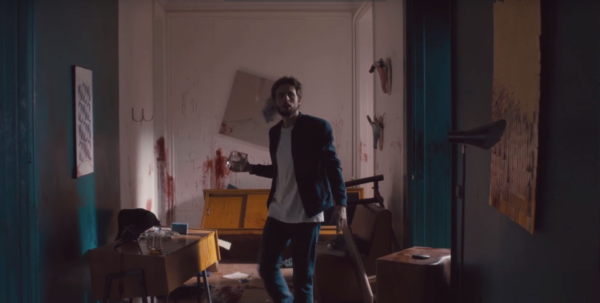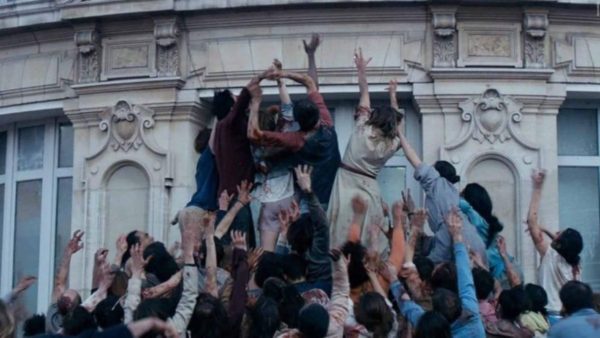
We’ve seen innumerable takes on the zombie film, so what does French zombie flick La nuit a dévoré le monde / The Night Eats The World bring that’s new to the table?
Let’s bitch it out…
It’s worth acknowledging right off the top the initial scenes from Dominique Rocher’s first film appear to draw inspiration from Danny Boyle’s zombie classic 28 Days Later. Comparisons are inevitable: both films feature male protagonists who – for one reason or another – sit out the initial stage of an outbreak and wake up to find a deserted world populated almost exclusively with zombies. Swap out London for Paris and the premise appears to be, on the surface, identical.
In truth, La nuit a dévoré le monde is a much more introspective consideration of the scenario. Whereas Boyle’s film slowly mutates into a military drama that reveals humans are the true monsters (an argument that The Walking Dead can’t seem to move beyond), screenwriter Jérémie Guez doubles down on the survivalist angle, delving deeply into the psychological impact of living through an apocalyptic event all by yourself.
Sam (Anders Danielsen Lie) is introduced wearily making his way up the stairs to his ex-girlfriend’s Parisian flat. He’s there to pick up a box of tapes and leave, but Fanny (Sigrid Bouaziz) refuses to indulge him, insisting that he stick around and mingle. The scenes that follow gently foreshadow his fate: Sam sits alone on the couch, wanders the halls without speaking to anyone and, after an accidental blow to the nose, eventually wanders into an empty office where he passes out. Despite the presence of other humans, Sam is already alone.
When he awakens the next morning, the world is already transformed. The flat is in shackles, blood covers the walls and floors, and no one is around. Sam discovers a zombified Fanny on the stairs and barricades himself in her apartment, which is where he more or less remains for the rest of the film.
At this point – less than ten minutes in – La nuit a dévoré le monde transforms into a one man show. Sam proves surprisingly adaptable once he adjusts to the new world order: he cleans the apartment to make it livable, then tentatively begins exploring the building, gathering food and supplies, locking doors and windows and blocking off zombified residences as he goes. There are a few moments of explicit horror, such as when he is unexpectedly attacked by a zombie family in one unit, but for the most part the film is interested in the drama of how Sam survives.

With only the occasional zombie interaction to play off of, Danielsen Lie singlehandedly carries the film. He is onscreen in every scene, without the benefit of dialogue to communicate Sam’s state of mind. It’s an exceptional performance, and surprisingly layered; Rocher uses a few montages, Sam’s haircut and changes in seasons to communicate the passage of time, but the real effects of loneliness and isolation are captured in Danielsen Lie’s physical performance, particularly in his face.
Scenes where Sam surveys the deserted city from the rooftop and shoots paintballs at zombies on the street below (reminiscent of Zack Synder’s Dawn of the Dead remake) reinforces his slowly deteriorating mental state. One notable scene finds him preparing a nighttime bath in the dead of winter, and the combination of paranoia at every little sound and the infantilism in his fetal body position is haunting. Little wonder that the most affecting developments in the film involve his interactions with other “living” creatures, including the bond he forms with Alfred (Denis Lavant), a zombified tenant locked in the elevator, and a stray cat he nearly dies trying to rescue outside of the apartment building.
Sam’s day to day routine forms the crux of the narrative, which helps to distance La nuit a dévoré le monde from traditional zombie films that rely on sporadic attacks. Rocher films this in a fairly unassuming way, opting primarily for medium shots unless it’s an action sequence when the camerawork gets more frenetic. The lack of soundtrack is also unique, particularly in the early portion of the film where the silence contributes to the film’s unsettling tone (Sam eventually comes to rely on the tapes he originally came to pick up, as well as the hard rock music and drum kit he finds in a neighbour’s unit, to keep himself company).
Perhaps because of the film’s interest in Sam’s slow mental deterioration, its 94 minute runtime can feel a little bit longer. The pacing between the second and third act transition drags a little, so that by the time another human being inevitably arrives, it feels too little too late. The ensuing conflict bears a number of familiar plot beats, leading to an ending that is both nihilistic and optimistic at the same time. It is, however, very reflective of the film’s overall tone.
The Bottom Line: La nuit a dévoré le monde starts off in familiar zombie territory, but quickly distinguishes itself as more of a character drama about one man’s isolation and despair. The singular focus on Sam encourages deep audience investment in his journey, which is greatly helped by Danielsen Lie’s sympathetic performance. While there are some minor pacing issues that make the film feel a little longer than it actually is, La nuit a dévoré le monde still earns a strong recommendation, particularly for fans of character-driven, psychological horror.
La nuit a dévoré le monde / The Night Eats The World played at Fantasia Festival Friday, July 13
